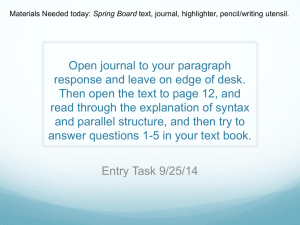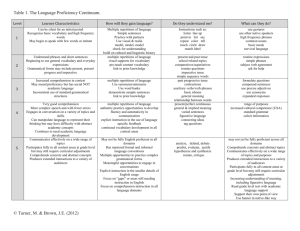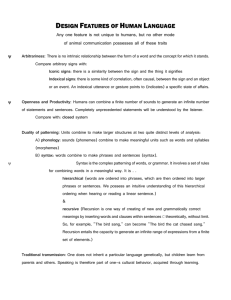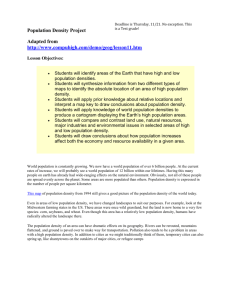speaking and listening
advertisement
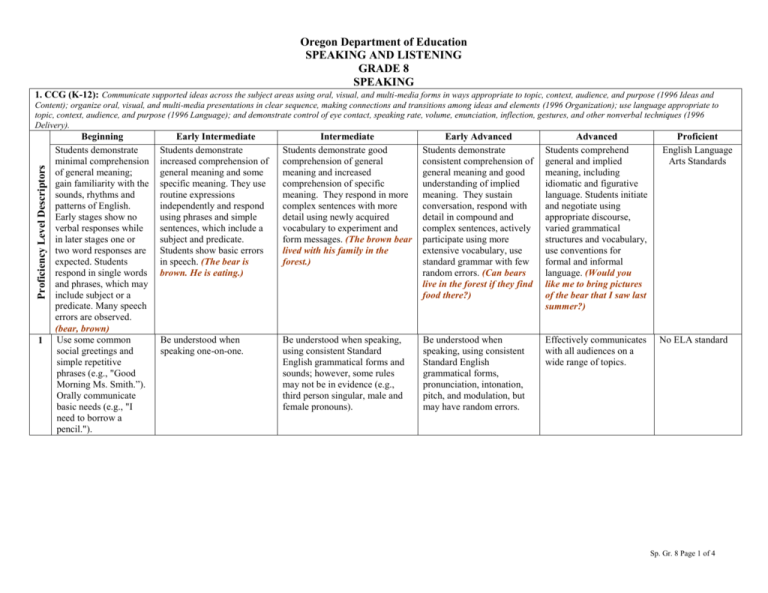
Oregon Department of Education SPEAKING AND LISTENING GRADE 8 SPEAKING 1. CCG (K-12): Communicate supported ideas across the subject areas using oral, visual, and multi-media forms in ways appropriate to topic, context, audience, and purpose (1996 Ideas and Proficiency Level Descriptors Content); organize oral, visual, and multi-media presentations in clear sequence, making connections and transitions among ideas and elements (1996 Organization); use language appropriate to topic, context, audience, and purpose (1996 Language); and demonstrate control of eye contact, speaking rate, volume, enunciation, inflection, gestures, and other nonverbal techniques (1996 Delivery). 1 Beginning Students demonstrate minimal comprehension of general meaning; gain familiarity with the sounds, rhythms and patterns of English. Early stages show no verbal responses while in later stages one or two word responses are expected. Students respond in single words and phrases, which may include subject or a predicate. Many speech errors are observed. (bear, brown) Use some common social greetings and simple repetitive phrases (e.g., "Good Morning Ms. Smith.”). Orally communicate basic needs (e.g., "I need to borrow a pencil."). Early Intermediate Students demonstrate increased comprehension of general meaning and some specific meaning. They use routine expressions independently and respond using phrases and simple sentences, which include a subject and predicate. Students show basic errors in speech. (The bear is brown. He is eating.) Intermediate Students demonstrate good comprehension of general meaning and increased comprehension of specific meaning. They respond in more complex sentences with more detail using newly acquired vocabulary to experiment and form messages. (The brown bear lived with his family in the forest.) Early Advanced Students demonstrate consistent comprehension of general meaning and good understanding of implied meaning. They sustain conversation, respond with detail in compound and complex sentences, actively participate using more extensive vocabulary, use standard grammar with few random errors. (Can bears live in the forest if they find food there?) Advanced Students comprehend general and implied meaning, including idiomatic and figurative language. Students initiate and negotiate using appropriate discourse, varied grammatical structures and vocabulary, use conventions for formal and informal language. (Would you like me to bring pictures of the bear that I saw last summer?) Be understood when speaking one-on-one. Be understood when speaking, using consistent Standard English grammatical forms and sounds; however, some rules may not be in evidence (e.g., third person singular, male and female pronouns). Be understood when speaking, using consistent Standard English grammatical forms, pronunciation, intonation, pitch, and modulation, but may have random errors. Effectively communicates with all audiences on a wide range of topics. Proficient English Language Arts Standards No ELA standard Sp. Gr. 8 Page 1 of 4 Oregon Department of Education SPEAKING AND LISTENING GRADE 8 SPEAKING (cont.) Beginning Early Intermediate Asks and answers questions using phrases or simple sentences. Intermediate Actively participates in social conversations with peers and adults on familiar topics by asking and answering questions and soliciting information. Begins to speak with a few words or short sentences, using some English phonemes and rudimentary English grammatical forms (e.g., single words or phrases). . Begins to be understood when speaking, but may have some inconsistent use of Standard English, grammatical forms and sounds (e.g., plurals, simple past tense, and pronouns [he/she]). Uses simple sentences to create a draft of a short oral presentation. Responds by asking simple questions or by making brief restatement. 2 3 4 5 Early Advanced Actively participates and initiates more extended social conversations with peers and adults on unfamiliar topics by asking and answering questions, restating and soliciting information. Selects a main idea and develops a brief oral presentation. Advanced Actively participates and initiates conversations in an academic setting. Proficient No ELA standard Selects a main idea and focus that appeals to the background and interests of the audience and develops an oral presentation. Follows an outline model to create a brief oral presentation. Following an outline model which includes an introduction, body and conclusion, creates a draft of a brief oral presentation. Uses an outline to independently create a short oral presentation which includes an introduction, transitions, body and conclusion. Uses credible information and identifies relevant information to convey message about familiar and content area topics using phrases and short sentences. Uses credible information. Conveys message using simple sentences. Selects credible and relevant information to convey message. Develop a focus and point of view to achieve particular purposes and to appeal to the background and interests of the audience. Outline a speech based on a chosen pattern of organization, including an introduction; transitions, previews, and summaries; a logically developed body; and an effective conclusion. Use credible and relevant information to convey message. Sp. Gr. 8 Page 2 of 4 Oregon Department of Education SPEAKING AND LISTENING GRADE 8 SPEAKING (cont.) 6 7 8 9 Beginning Using modeling for feedback, rearranges words to clarify meaning. Early Intermediate Using modeling for feedback, rearranges words and simple sentences to clarify meaning. Intermediate Uses feedback, including nonverbal cues, to modify and rearrange words, phrases and simple sentences to clarify meaning. Early Advanced Uses feedback, including verbal and nonverbal cues, to modify and rearrange words, phrases and sentences to clarify the meaning. Advanced Uses feedback, including verbal and nonverbal cues, to reconsider and rearrange words, phrases, and sentences to clarify the meaning. Is understood when speaking, using consistent Standard English grammatical forms and sounds; however, some rules may not be in evidence (e.g., third person singular, male and female pronouns). Is understood when speaking, using consistent Standard English grammatical forms including the use of action verbs but may have random errors. Uses appropriate language, action verbs, details, and the active rather than the passive voice. Uses appropriate adjectives and pronouns. Consistently uses appropriate tenses (past, present, future). Uses appropriate enunciation, pace, eye contact and gestures when practicing for a formal presentation. Proficient Use feedback, including both verbal and nonverbal cues to reconsider and modify the organizational structure and to rearrange words and sentences to clarify the meaning. Use precise language, action verbs, sensory details, appropriate and colorful modifiers, and the active rather than the passive voice in ways that enliven oral presentations. Use appropriate grammar. Use appropriate enunciation, pace, eye contact and gestures to engage the audience during formal presentations. Sp. Gr. 8 Page 3 of 4 Oregon Department of Education SPEAKING AND LISTENING GRADE 8 SPEAKING (cont.) Beginning 10 Early Intermediate Speaks clearly and comprehensibly when working one-on-one. Intermediate Speaks clearly and comprehensibly when working in small groups. Early Advanced Speaks clearly and comprehensibly when practicing for a formal presentation. Advanced Proficient Sp. Gr. 8 Page 4 of 4

